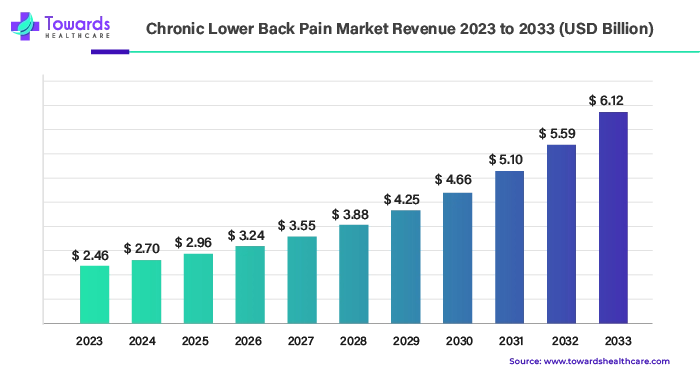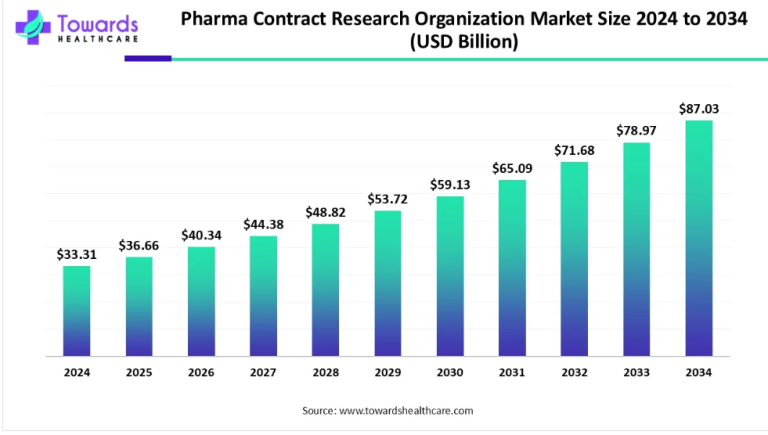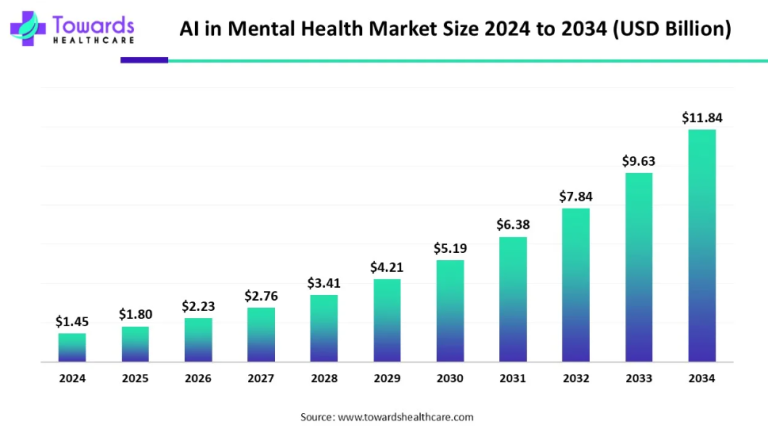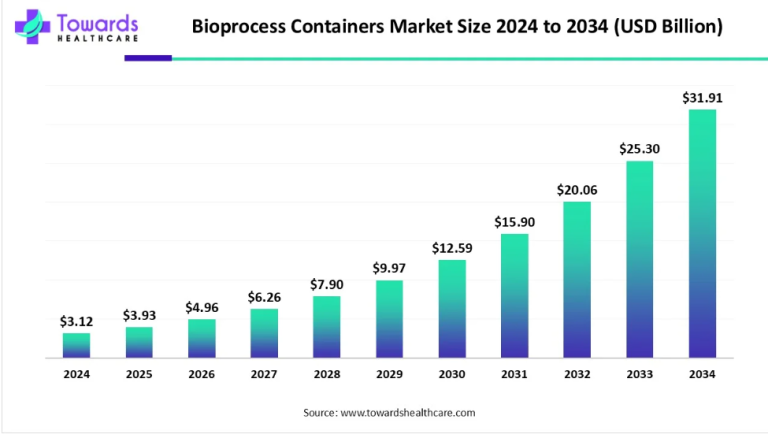
The chronic lower back pain market size is a dynamic and evolving sector within the healthcare industry, valued at US$ 2.46 billion in 2023 and projected to reach US$ 6.12 billion by 2033. This substantial growth represents an impressive CAGR of 9.52% from 2024 to 2033.
Key factors driving this market expansion include the increasing geriatric population and the rising prevalence of arthritis, a leading cause of chronic lower back pain.
Market Overview and Growth Drivers
Rising Prevalence of Chronic Lower Back Pain
- Chronic lower back pain (CLBP) is a persistent condition that affects millions of people worldwide. It is characterized by pain that persists for 12 weeks or longer, despite treatment. This condition significantly impacts quality of life, leading to physical limitations and economic burdens due to healthcare costs and lost productivity. The rising prevalence of CLBP is a primary driver of market growth.
Increasing Geriatric Population
- The global population is aging, with a significant increase in the number of individuals aged 65 and older. This demographic shift is critical because older adults are more susceptible to conditions such as arthritis and osteoporosis, which are major contributors to chronic lower back pain. The geriatric population’s demand for effective pain management solutions is thus propelling the market forward.
Impact of Arthritis on Market Growth
- Arthritis, particularly osteoarthritis and rheumatoid arthritis, is a leading cause of chronic lower back pain. As the incidence of arthritis increases, so does the demand for treatments and interventions to manage this condition. Innovations in medical technology and pharmaceuticals are continually being developed to address the needs of arthritis patients, further boosting the market for CLBP treatments.
Innovations and Future Trends
Advances in Drug Development
- Pharmaceutical companies are investing heavily in the development of new drugs for chronic lower back pain. This includes the creation of more effective NSAIDs, safer opioids, and novel classes of medications such as biologics and gene therapies. These innovations are expected to offer better pain management options with fewer side effects.
Technological Innovations in Medical Devices
- The medical device segment is also seeing significant advancements. Minimally invasive spinal surgeries, neurostimulation devices, and robotic-assisted procedures are some of the cutting-edge technologies being developed. These innovations aim to provide more effective pain relief with shorter recovery times and fewer complications.
Growing Popularity of Integrative and Alternative Therapies
- There is a growing trend towards integrative and alternative therapies for managing chronic lower back pain. Yoga, pilates, tai chi, and mindfulness-based stress reduction (MBSR) are gaining popularity as complementary treatments. These therapies are often used in conjunction with traditional medical treatments to enhance overall outcomes.
Focus on Personalized Medicine
- Personalized medicine, which tailors treatments to individual patient characteristics, is becoming increasingly important in the chronic lower back pain market. Advances in genomics and biomarker research are enabling more precise diagnosis and treatment, improving patient outcomes and reducing trial-and-error prescribing.
Challenges and Opportunities
Regulatory Challenges
- The chronic lower back pain market faces several regulatory challenges, particularly regarding the approval and reimbursement of new treatments. Navigating these regulatory pathways can be complex and time-consuming, but successful navigation is crucial for market entry and growth.
Opportunities in Emerging Markets
- Emerging markets present significant opportunities for growth in the chronic lower back pain market. Increasing healthcare access, rising disposable incomes, and growing awareness about chronic pain management are driving demand in these regions. Companies that can effectively penetrate these markets stand to gain substantial market share.
Addressing the Opioid Crisis
- The opioid crisis poses both challenges and opportunities for the chronic lower back pain market. While concerns about opioid addiction have led to stricter regulations and decreased opioid prescriptions, they have also spurred innovation in alternative pain management strategies. Developing effective non-opioid treatments is a key area of focus for the industry.
Regional Insights on the Chronic Lower Back Pain Market
North America Dominates the Market in 2023
In 2023, North America led the chronic lower back pain market with the largest market share. According to the Centers for Disease Control and Prevention, chronic pain affects 50 million people in the U.S., defined as pain lasting more than six months. Veterans experience chronic pain more frequently and intensely than the general population. Chronic pain can lead to depression, anxiety, insomnia, a reduced quality of life, and substance abuse disorders, and it increases the risk of suicide. Low back pain is one of the leading causes of disability among U.S. adults, and the use of opioids for pain management can have harmful side effects. Over 65 million Americans reported experiencing recent back pain, and 8% of adults (around 16 million people) suffer from chronic or persistent back pain, hindering their daily activities. Back pain ranks as the sixth most costly medical condition in the U.S., with healthcare and related indirect costs exceeding $12 billion annually. Additionally, back pain results in an estimated 83 million missed workdays each year.
In Canada, back pain is one of the most common chronic conditions. Four out of five adults will experience back pain at some point in their lives, with the most common cases occurring between the ages of 30 and 50. Both men and women are equally affected by back issues. Canada spends an estimated $6 to $12 billion annually on medical expenses for treating low back pain, not including societal costs due to lost worker productivity and disability benefits.
Chronic Lower Back Pain Market News
- May 2024: AppliedVR, a leader in immersive treatments, introduced its main prescription medication, RelieVRx®, into workers’ compensation. RelieVRx is the first FDA-cleared, fully immersive virtual reality therapy for persistent lower back pain.
- December 2023: The World Health Organization (WHO) announced the first global guidelines for treating low back pain, affecting approximately 619 million people worldwide. The guidelines provide various non-surgical treatment options for primary and community care settings to enhance the quality of care for millions suffering from this condition.
- August 2023: NRx Pharmaceuticals, Inc., a clinical-stage biopharmaceutical company, submitted an Investigational New Drug (IND) application to the FDA for NRX-101 as a treatment for chronic pain. The application utilizes advanced research on D-cycloserine, a key component of NRX-101, for chronic pain therapy.
- June 2023: Aspen Medical Products launched the Horizon PRO range of lower spine braces, aimed at alleviating symptoms associated with lower back pain due to muscular strain and spasms. Aspen’s Horizon PRO series features scientifically proven tri-band technology to enhance trunk stability, reducing the strain on overworked muscles and relieving severe lower back pain.
Segments Covered in Chronic Lower Back Pain Market Report
By Drug Class
- Non-steroidal Anti-inflammatory Drugs
- Antidepressants
- Analgesic
- Opioids
- Others
By Route of Administration
- Oral
- Topical
- Others
By Distribution Channel
- Hospital Pharmacies
- Retail & Online Pharmacies
By Region
- North America
- Europe
- Asia Pacific
- Latin America
- Middle East & Africa
To own our research study instantly, Click here @ https://www.towardshealthcare.com/price/5156
Read more about Chronic Lower Back Pain Market:
You can place an order or ask any questions, please feel free to contact us at sales@towardshealthcare.com
About Us
Healthcare Web Wire is a premier subsidiary of Towards Healthcare, dedicated to providing comprehensive insights and information related to the healthcare industry. With a commitment to delivering accurate and timely updates, Healthcare Web Wire serves as a vital resource for professionals, enthusiasts, and stakeholders within the healthcare sector. Our platform serves as a central hub for the latest news, trends and developments shaping the healthcare landscape. Join us on Healthcare Web Wire and become part of a vibrant community dedicated to advancing healthcare knowledge and shaping the future of healthcare worldwide.
Explore the comprehensive statistics and insights on healthcare industry data and its associated segmentation: Get a Subscription
For Latest Update Follow Us: https://www.linkedin.com/company/towards-healthcare



